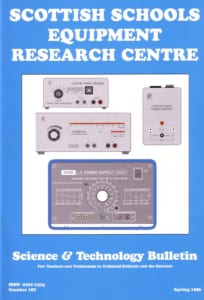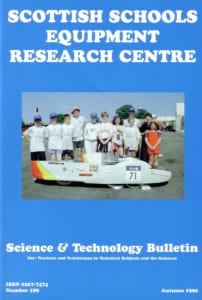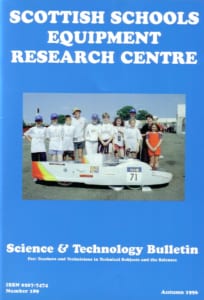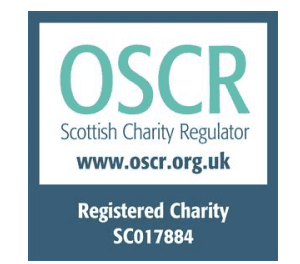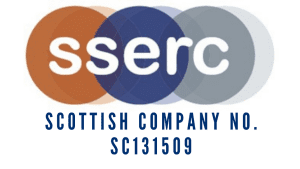The page numbers refer to the pages in the pdf. (The numbers in brackets are those given in the actual bulletin)
3(1) News and Comment
Apology for no Winter issue, Future of SSERC, SCRE report, CLEAPSS Director, ASE Scotland AGM, IoB Meeting, Damned if they. . . Kurt but decent
5(3) Perceptions of risk
A number of factors which influence both individual and societal perceptions of risk are reviewed. Some limitations of probabilistic approaches are discussed. Arguments are made for the inclusion of some of these ideas in science and technology curricula. A summary list of such ideas is provided.
10(8) SOED Circular 8/95 on carcinogens
The broad purpose and philosophy behind the circular, prepared by SSERC on behalf of the SOED, are explained. The basic risk assessment approach adopted for this advisory document is illustrated with examples.
12(10) Simple pneumatics kit
New Pr-Mid range from Polytech 2000 suits 5 to 14 curriculum.
12(10) Microbiology videos
We have received some videos for review from the National Centre for Biotechnology Education (NCBE).
13(11) New DNA technology kit : an interim review
A first look at a new, joint, NCBE and SAPS kit for the investigation of DNA technologies
14(12) Laboratory power supplies
In this second article on laboratory power supplies we review products from Griffin and Irwin.
24(22) Discussion Paper Investigations in the Sciences
The paper in science investigations published here was prepared by teachers and members of the advisorate in Borders Region.
26(24) Hazards of man-made mineral fibres
About 20 years ago the use of asbestos products was discontinued in laboratory science because of the danger to health which had by then become evident. Ceramic fibres, a type of man-made mineral fibre (MMMF), were substituted. This article reviews recent evidence that ceramic fibres may also be carcinogenic, assesses the risks and advises on control measures.
29(27) Soluble starch
What is the best type of starch?
30(28) Diabur test strips
An alternative to Clinistix.
The page numbers refer to the pages in the pdf. (The numbers in brackets are those given in the actual bulletin)
3(1) News and Comment
Future of SSERC, Inaugural IoB meeting, Science Review Group Report, What’s wrong with electronics? Harris and Unilab, Another science teacher fined.
5(3) Safety Notes
Disintegrating reagent bottles, New safety publications
6(4) SOEID Circular 7/95 on lasers
The purpose and ideas behind the circular [1], prepared by SSERC on behalf of SQEID, are explained. Basically the circular updates controls on the use of lasers to conform with present health and safety legislation, laser standards and practices.
9(7) Ultrabright LED5 in educational products
Although at the time of writing this note we are still awaiting a decision by an IEC technical committee on how to assess the hazards of LED radiation, we know of two educational products incorporating ultrabright LEDs whose radiation may possibly be harmful.
10(8) Radford Labpacks
Potential safety issues.
10(8) Bulgin mains plugs
Bulgin Components plc have issued a warning to customers and to the press of a plastic welding defect in a small number of their plugs.
10(8) Apple MAC danger
Some dangerous faults found.
11(9) Earth system on Lancashire Power Unit
The following notes relate to the protective earth system on the obsolete Unilab power supply 122.312 built to a specification from Lancashire County Council – hence the name. This product was phased out in the early 1980s.
12(10) Optics with lasers
One of the purposes of Circular 7/95 was to widen the scope of laboratory work with lasers. This article describes ways of using laser radiation with ray optics and with spherical lenses. It includes models of double refraction and internal reflection within a water droplet to explain the rainbow.
19(17) Ball lens making
You can make your own ball lenses with soda glass rod. However no matter how good the result may look, it must be tested empirically to find whether it is satisfactory.
21(19) Examples of family logic
Each logic family has its own set of operating rules. In this article we look at differences between three widely used families, LS, HC and 4000B series metal gate, in the context of the sequential controller within Case Study 3, being part of support material for Higher Grade Technological Studies.
26(24) Preparation of hydrogen
Gases can be prepared with simple home-made apparatus held together with string and sealing wax. The generators and on-off control.
28(26) Hot to touch warning labels
Aldrich and Sigma supply self-adhesive, waterproof, plastic coated labels which change from black to orange and display the word ‘HOT” in red letters.
29(27) DCPIP – colour changes
We had enquiries recently on the nature of the colour change to expect with this redox indicator in the presence of ascorbic acid (vitamin C).
30(28) Skin sensitivity
The wisdom (or otherwise) of continuing to use dividers or similar metal implements for the purpose of testing the varying sensitivity to touch or contact of human skin
30(28) Technicians’ News
S/NVQ update
31(29) Trade News
Harris and Unilab, PTFE taps in burettes
32(30) Equipment Offers
The page numbers refer to the pages in the pdf. (The numbers in brackets are those given in the actual bulletin)
3(1) News and Comment
New SSERC address, Membership, National chemistry conference, ASE Scotland meeting, TEP moves on
4(2) Smaller still – curricular paradoxes
5(3) Safety Notes
Prosecution under IRR(85), Health and safety bibliography, Health and safety training, Be Safe! Reprinted, Living materials revised code of practice, Seeing red : new extinguisher colours, Eye protector markings, Pressure systems : autoclaves etc. Possible revision : RPA requirement
8(6) DNA from bacterial cells
A rapid extraction method is described which demonstrates the presence of deoxyribose nucleic acid in bacterial cells. The procedure also provides a simple means of distinguishing Gram-positive from Gram-negative bacteria and has potential for detecting contamination of certain types of stock culture.
Microbiological tips
11(9) Mouthwashes
The antimicrobial activity, claimed or implied, of proprietary mouthwashes is becoming a popular topic for projects and investigations.
11(9) Plooky parallel
Investigating products claiming to control blemishes on teenage skin.
11(9) Juicy problem
V8 Juice Agar is a richer vegetarian variant of similar media.
12(10) MOSFETs
The operation of MOSFETs depends on elementary principles of physics. Factors affecting channel current can be investigated experimentally, from which a mathematical model can be constructed. The model can then be derived theoretically.
21(19) Description of Chip 2 : The MOS Transistor
Practical work in the previous article was carried out on Chip 2 of the Edinburgh University Teaching Chip set. Here we provide the specification of Chip 2 and give some tips on handling.
Technical Tips
23(21) Unilab timing ball
How the battery can be replaced.
23(21) Electricity generation
A simple means of showing how electricity can be generated by steam.
24(22) Fehling’s – an even safer substitute
In this note the hazards and risks attendant on the use of Fehling’s solutions in testing for reducing sugars and some other reducing agents are discussed. Three safer substitutes are suggested : Benedict’s Reagent, Barfoed’s Reagent and one described more recently by Sandell
25(23) Tiles : heating metals and oxides
In Bulletin 187 we reviewed recent evidence that, in certain forms, some man-made fibres (MMF) may be carcinogenic. That article also assessed the risks of some specific educational uses of such fibres.
26(24) Sheeps’ eyes : dissection
A change in the regulations.
27(25) Publications
CLEAPSS Lab Handbook, SSERC ‘s: “Interfacing for . . .” series
27(25) Odds and ends
Glycogen (grade and source) , Plethysmography
28(26) Equipment offers

